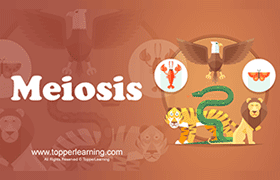ICSE Class 10 Answered
Explain about meiosis-2.
Asked by jaiswalsindhuli717 | 25 Sep, 2018, 06:01: PM
- Meiosis-II resembles mitotic division.
- In this division, the two chromatids of each chromosome separate from each other and go to separate daughter cells.
- The number of chromosomes remains the same as produced by meiosis-I.
- Meiosis-II consists of four stages—prophase-II, metaphase-II, anaphase-II and telophase-II.
Prophase-II
- During prophase-II, the already duplicated centrioles move in pairs to the opposite poles.
- Each pair of centrioles develops astral rays round it to form an aster.
- A spindle is laid down between the two pairs of centrioles.
- The nuclear membrane and the nucleolus disintegrate and disappear.
- The chromatin fibres undergo compaction and appear in the form of distinct chromosomes.
- Each chromosome consists of two chromatid threads joined by a centromere.
Metaphase-II
- During metaphase-II, the chromosomes come to lie on the equator of the cell and form a single equatorial or metaphasic plate.
- The spindle fibres become attached to both kinetochores of the centromere of each chromosome.
Anaphase-II
- During anaphase-II, the two chromatids of each chromosome start moving away from each other.
- They reach the poles of the spindle where they are called chromosomes.
- Each pole has a haploid number of chromosomes and haploid amount of DNA.
Telophase-II
- During telophase-II, the daughter chromosomes on the opposite poles decondense to form
chromatin fibres. - The nuclear envelope develops from the endoplasmic reticulum and the new nucleolus reorganises.
- The spindle fibres and astral rays disintegrate and disappear.
- This marks the end of telophase-II and karyokinesis of meiosis-II.
Cytokinesis-II
- Cytokinesis follows karyokinesis of meiosis-II.
- The cytoplasm divides in the middle by furrowing in an animal cell and by cell plate formation in a plant cell.
- At the end of cytokinesis, two daughter cells are formed, each with half the number of chromosomes and half the amount of nuclear DNA of the parent cell.
- Cytokinesis may occur successively after each nuclear division.
- The diploid parent cell divides first by heterotypic division into two haploid cells, which then produce four haploid cells by homotypic division.
- The four daughter cells may form a linear or isobilateral tetrad.
Answered by Sheetal Kolte | 26 Sep, 2018, 12:13: PM
Concept Videos
ICSE 10 - Biology
Asked by banuv078730 | 17 Mar, 2021, 10:18: PM
ICSE 10 - Biology
Asked by anisha.bts77 | 15 Feb, 2021, 11:22: PM
ICSE 10 - Biology
Asked by adarshsasi2005 | 28 Jul, 2020, 07:52: PM
ICSE 10 - Biology
Asked by ssatapathy307 | 21 Jul, 2020, 05:50: PM
ICSE 10 - Biology
Asked by sharayurokade48.10spicertl | 15 May, 2020, 10:15: AM
ICSE 10 - Biology
Asked by getsallu786 | 04 May, 2020, 02:43: AM
ICSE 10 - Biology
Asked by aadrica.kanika | 15 Apr, 2019, 10:27: PM
ICSE 10 - Biology
Asked by swayamdesai54689 | 12 Mar, 2019, 06:49: PM
ICSE 10 - Biology
Asked by manojmar | 10 Feb, 2019, 02:20: PM
ICSE 10 - Biology
Asked by indrasish43 | 18 Jan, 2019, 07:16: PM


